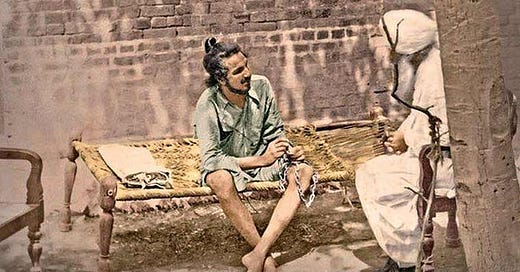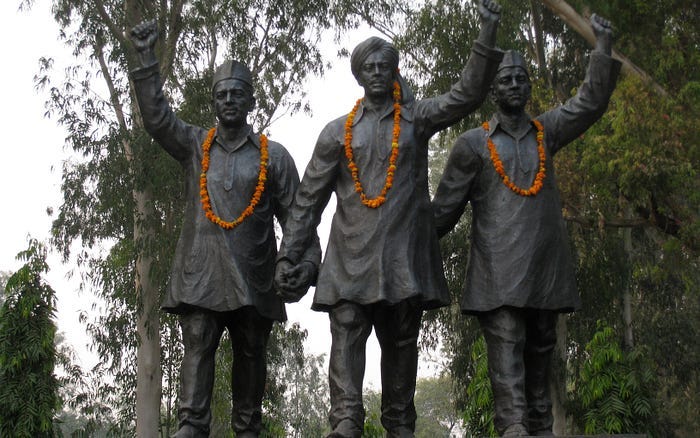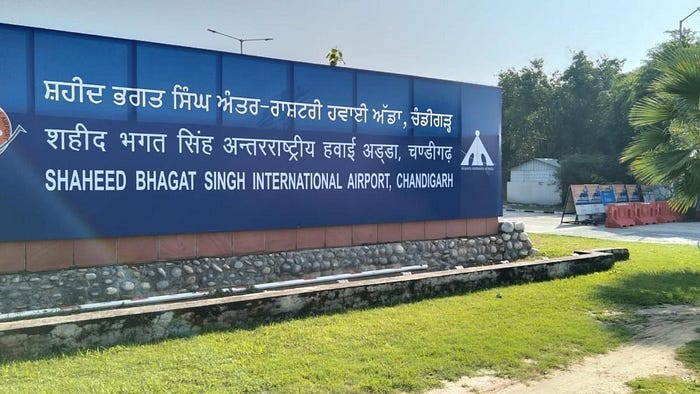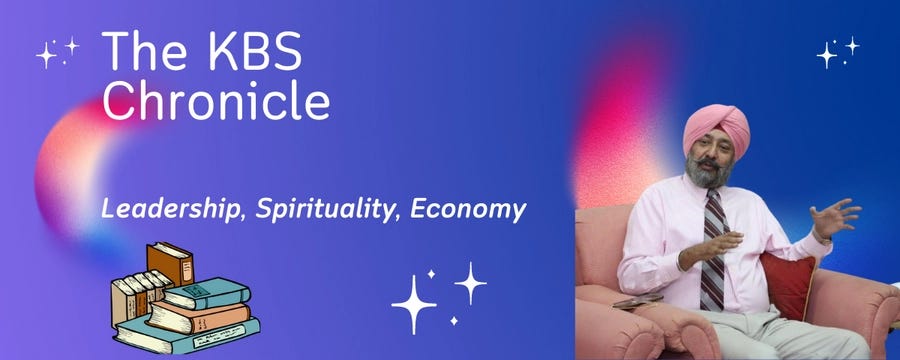Shahid-e-Azam Bhagat Singh: A Martyr for India's Freedom
Get to Know the Revolutionary Hero: 20 Questions About Shahid-e-Azam Bhagat Singh. How many can you answer? ANSWERS ADDED.
🙏 ਪ੍ਰਣਾਮ ਸ਼ਹੀਦਾਂ ਨੂੰ 🙏
Legends are Immortal
Today, on the 28th September 2024, as we commemorate the birth anniversary of one of India’s most iconic freedom fighters, Shahid-e-Azam Bhagat Singh, we revisit our article, in the nature of a quiz, that we wrote over a year ago on the occasion of his Martyrdom Day on 23rd March, 2023.
Born in 1907 in a family of revolutionary activists, Bhagat Singh grew up with a deep commitment to the cause of Indian independence. He was a prolific writer, a fearless orator, and a revolutionary thinker who challenged the colonial power and inspired a generation of Indians to fight for their rights and freedoms. Bhagat Singh’s life and work remain an inspiration to millions of people in India and around the world, who continue to struggle for justice, equality, and dignity. On this day, we remember his courage, his vision, and his sacrifices, and we reaffirm our commitment to the values that he fought and died for. May his legacy continue to guide and inspire us in our ongoing struggles for a better world.
20 question about his life and legacy
While we all pay homage to him and his two associates today, please make time to answer these questions about him. Even if you google for answers— for refer to ChatGPT4—, good — at least you will have at least something more about the legendary hero. Do leave your thoughts for improvement in the comments section, or suggest correct answers, where my rudimentary reseach might have been wrong.
1. Where and when was Shahid Bhagat Singh born?
Shaheed Bhagat Singh was born on September 28, 1907, in the village of Banga, Lyallpur district, Punjab, which is now in Pakistan.
2. Although caste of the free-fighters and those who laid down their life at the altar of freedom does not matter, what was the caste, religion and surname of the family he was born into?
Shaheed Bhagat Singh was born into a Sikh family that belonged to the Sandhu Jat community. The surname of the family he was born into is Sandhu. His family was actively involved in the struggle for India's independence and had a strong tradition of participation in movements against the British Raj. Bhagat Singh himself, though deeply influenced by his Sikh heritage, later adopted a more secular and socialist worldview in his fight against colonial rule.
3. What was the level of his formal education?
Bhagat Singh received formal education up to the 12th grade. After attending the Dayanand Anglo-Vedic High School in Lahore, he enrolled at the National College in Lahore, which was a hub for revolutionary activities and ideas. It was here that Bhagat Singh's political thoughts were significantly shaped, and he became deeply involved in the freedom movement. Despite not pursuing higher formal education, Bhagat Singh was a voracious reader and self-educated in various subjects including politics, history, and social sciences, which deeply influenced his revolutionary activities and writings.
4. What languages could be read and write?
Bhagat Singh was proficient in several languages. He could read and write in Punjabi, Hindi, Urdu, and English. His multilingual abilities not only facilitated his deep engagement with a broad range of revolutionary literature and ideas from different parts of the world but also helped him connect with a diverse population across India in his fight against British colonial rule. Bhagat Singh's writings and correspondences, which include letters, essays, and articles advocating for India's independence and social reform, were penned in these languages, reflecting his intellectual breadth and commitment to the cause of freedom.
5. Was he ever married, engaged to, or otherwise romantically involved with any woman?
No, Bhagat Singh was never married, engaged, or known to be romantically involved with anyone. He dedicated his life entirely to the cause of India's freedom from British rule. Bhagat Singh's focus was solely on the struggle for independence, and he is often quoted as having been wary of any personal attachments that could distract him from his revolutionary activities. His commitment to the cause was such that personal matters, including marriage or romantic involvements, were set aside in favour of the greater goal he pursued.
6. Where was he on 13th April, 1919, when the Jallianwala Bagh Massacre took place?
On April 13, 1919, the day of the Jallianwala Bagh Massacre, Bhagat Singh was in his hometown. He was deeply affected by the events of that day, despite being only 11 years old at the time. The massacre, where British troops led by General Dyer fired on a large crowd of unarmed civilians gathered at Jallianwala Bagh in Amritsar, Punjab, killing hundreds and injuring thousands, had a profound impact on him. Bhagat Singh visited the site of the massacre the following day, collecting soil soaked with the blood of the victims, which he kept as a memento. This event is often cited as a turning point in his life, deeply influencing his resolve to drive the British out of India.
7. Did he ever meet Shaheed Udham Singh in his lifetime? If so, where and when?
There is no documented evidence to suggest that Bhagat Singh ever met Udham Singh, another prominent figure in the Indian independence movement known for assassinating Michael O'Dwyer in London in 1940 as an act of revenge for the Jallianwala Bagh Massacre. Both Bhagat Singh and Udham Singh were deeply influenced by the massacre and dedicated their lives to the struggle for India's independence, but their paths in the freedom struggle did not cross in a way that is recorded or historically verified. Their lives and actions were parallel narratives within the broader tapestry of India's fight against British colonial rule, with each playing a significant role in inspiring future generations of Indians to continue the struggle for freedom.
8. Of which organisation was he the member?
Bhagat Singh was a prominent member of several revolutionary organizations dedicated to the cause of India's independence. The most notable among these were:
Hindustan Republican Association (HRA): Later known as the Hindustan Socialist Republican Association (HSRA), this was the primary organization with which Bhagat Singh was associated. The HRA aimed to overthrow British rule in India through armed rebellion and establish a Federal Republic of the United States of India based on socialist principles. Bhagat Singh joined the HRA in 1924 and quickly became a leading figure within the organization, contributing to its ideology and participating in its activities.
Naujawan Bharat Sabha: Founded by Bhagat Singh in 1926, the Naujawan Bharat Sabha was an organization that aimed to promote revolutionary activities against the British Raj among the youth of India. It also sought to inculcate a sense of unity, irrespective of religious or communal divides, and worked towards social reform.
Through these organizations, Bhagat Singh was involved in planning and executing acts of resistance against the British authorities, including the Lahore Conspiracy Case and the bombing of the Central Legislative Assembly. His involvement with these groups placed him at the forefront of the revolutionary movement in India, making him one of the most influential and celebrated freedom fighters in the history of India's struggle for independence.
9. Was he influenced by Shahid Kartar Singh Sarabha? Did he meet him in person?
Yes, Bhagat Singh was profoundly influenced by Kartar Singh Sarabha, a key member of the Ghadar Party and a revolutionary who was executed by the British in 1915 for his role in the Ghadar Conspiracy during World War I. Despite the age difference and the fact that Sarabha was executed when Bhagat Singh was just eight years old, the legacy and ideals of Kartar Singh Sarabha left a lasting impact on him.
Bhagat Singh often spoke about the deep inspiration he drew from Sarabha's life and sacrifice. He considered Sarabha as his hero and mentor, even though they never met in person. Bhagat Singh's family and the wider revolutionary community he was part of frequently discussed the courage and dedication of martyrs like Sarabha, which instilled in him a strong resolve to dedicate his life to the freedom struggle.
The influence of Kartar Singh Sarabha on Bhagat Singh is a prime example of how the legacy of earlier revolutionaries inspired subsequent generations in the Indian independence movement, creating a continuity of resistance against British rule.
10. Are his pictures wearing a hat, hair cut short and clean-shaven look derived from real-life photographs, or are they merely an artist’s imagination?
The pictures of Bhagat Singh wearing a hat, with his hair cut short and appearing clean-shaven, are derived from real-life photographs, not merely an artist's imagination. These images capture a distinct period in Bhagat Singh's life when he dramatically changed his appearance to evade capture by the British police after the killing of John Saunders in 1928.
Bhagat Singh traditionally wore a turban as part of his Sikh identity. However, to avoid recognition and arrest after the Saunders incident, he cut his hair, shaved his beard, and adopted Western attire, including a hat. This disguise allowed him to escape Lahore and travel to Calcutta. One of the most iconic photographs of Bhagat Singh in this disguise was taken in a photography studio during this period. This image has become one of the most enduring representations of Bhagat Singh, symbolizing his adaptability, commitment to the cause, and the lengths to which he would go for India's freedom.
These photographs are a testament to Bhagat Singh's revolutionary spirit and his readiness to sacrifice not just his life but also his identity for the cause he believed in.
11. Does his last photograph, taken while he was in Jail should long and unshorn hair?
Yes, Bhagat Singh's last known photograph, taken while he was in jail, shows him with long and unshorn hair. This photograph reflects his return to his Sikh roots, embracing the traditional appearance of keeping his hair long and wearing a turban, which was a departure from the earlier disguise of short hair and a hat that he had adopted to evade the British police. The image in jail, with his hair grown out, is symbolic of his pride in his heritage and his defiance against the colonial authorities, even in the face of death. This photograph has also become an iconic representation of Bhagat Singh, showcasing his bravery and steadfast commitment to his principles and to the struggle for India's independence.
12. When and where was he (and his associates) executed by the British?
Bhagat Singh and his associates, Shivaram Rajguru and Sukhdev Thapar, were executed by the British on March 23, 1931. The execution took place in the Lahore Central Jail, Punjab, which was then part of British India. Their execution was carried out in secrecy, hours ahead of the official time scheduled for the execution, and their bodies were cremated by the authorities on the banks of the Sutlej River in the middle of the night to avoid any public outcry and demonstrations. The martyrdom of Bhagat Singh, Rajguru, and Sukhdev was a pivotal moment in India's struggle for independence, inspiring generations of Indians to continue the fight against British rule.
After their execution on March 23, 1931, the British authorities, in an attempt to avoid public gatherings and potential unrest, secretly cremated Bhagat Singh, Shivaram Rajguru, and Sukhdev Thapar in the darkness of night. The cremation took place on the banks of the Sutlej River near Ferozepur, in the then Punjab Province of British India. To prevent any large-scale public demonstrations, the British took the bodies under the cover of darkness to a place called Hussainiwala on the banks of the Sutlej River, where they hastily cremated them.
This action by the British, intended to suppress any potential public outcry or homage to the martyrs, instead sparked immense anger and further solidified Bhagat Singh, Rajguru, and Sukhdev as enduring symbols of resistance and sacrifice in the Indian freedom struggle. Today, the site of their cremation, Hussainiwala, is a national martyr's memorial, paying tribute to their sacrifice for India's independence.
14. Give the full names of two of his associates, who were executed with him.
The full names of the two associates of Bhagat Singh who were executed with him are:
Shivaram Hari Rajguru
Sukhdev Thapar
15. Give basics of the “Lahore Conspiracy Case”. Who was the British Police Officer he and his associates assassinated?
The "Lahore Conspiracy Case" refers to a series of events and legal proceedings stemming from revolutionary activities against British rule in India, leading to the trial and execution of Bhagat Singh, Shivaram Rajguru, Sukhdev Thapar, and others. The case primarily revolved around two major incidents: the assassination of a British police officer and the bombing of the Central Legislative Assembly in Delhi.
Assassination of the British Police Officer: The officer assassinated by Bhagat Singh, Rajguru, and their associates was John Saunders. On December 17, 1928, in Lahore, they mistakenly killed Saunders, intending to assassinate James A. Scott, the Superintendent of Police, who had ordered a lathi charge that led to the death of Lala Lajpat Rai, a leading nationalist. This act of vengeance was meant to protest against the British government's repressive measures and to avenge Rai's death.
Lahore Conspiracy Case: Following the assassination, Bhagat Singh, Sukhdev, and Rajguru were implicated in what came to be known as the Lahore Conspiracy Case. Additionally, their involvement in the bombing of the Central Legislative Assembly on April 8, 1929, further complicated the case. Bhagat Singh and Batukeshwar Dutt threw non-lethal bombs and leaflets in the assembly to protest against the Public Safety Bill and the Trade Dispute Act, which were seen as repressive measures by the British government. They did not intend to harm anyone but to make their voices heard.
The trial of the Lahore Conspiracy Case was marked by significant controversy, including accusations of unfair proceedings and the defendants' use of the trial as a platform to publicize their cause for independence. Ultimately, Bhagat Singh, Sukhdev, and Rajguru were sentenced to death, leading to their execution on March 23, 1931. The case and the execution of these young revolutionaries ignited widespread anger and protest across India, making them martyrs and symbols of resistance in the struggle for India's independence.
16. Where and why Shahid-e-Azam Bhagat Singh throw bombs? How many people died in the incident?
Bhagat Singh, along with Batukeshwar Dutt, threw bombs in the Central Legislative Assembly in Delhi on April 8, 1929. This act was not intended to harm anyone but to protest against the Public Safety Bill and the Trade Dispute Act, which the revolutionaries saw as repressive measures being imposed by the British government to curb civil liberties and suppress the activities of political dissidents. The bombs were thrown in a relatively empty space to avoid causing injury, and leaflets were also scattered in the assembly hall, proclaiming their message.
The slogan "Inquilab Zindabad" (Long Live the Revolution) was shouted by Bhagat Singh and Dutt as they threw the bombs. The primary aim was to make the deaf hear; in other words, to draw attention to their cause and the injustice of British rule over India.
No one was killed in the incident. The bombs were designed to be loud but not lethal, ensuring that they served as a dramatic gesture rather than a deadly attack. Following the bombing, Bhagat Singh and Batukeshwar Dutt did not flee the scene; instead, they stayed and courted arrest, using their trial as a platform to publicize their cause and the demand for India's independence. This act of defiance and their subsequent trial garnered significant public attention and support for the freedom movement.
17. Did he ever travel to England? If so, when?
No, Bhagat Singh never travelled to England. Throughout his life and revolutionary activities, Bhagat Singh remained in India. His engagement with the struggle against British colonial rule was conducted entirely from within the country, through his involvement with various revolutionary organizations, writings, and direct actions against British authorities. Bhagat Singh's knowledge of global revolutionary movements and ideologies, including those from England and other parts of Europe, was acquired through extensive reading and intellectual engagement rather than personal travel. His understanding of these movements deeply influenced his thoughts and actions in the fight for India's independence.
18. Did he meet Mahatma Gandhi in person? If so when and where?
There is no documented evidence to suggest that Bhagat Singh ever met Mahatma Gandhi in person. While both were prominent figures in the Indian freedom struggle during the same historical period, their paths towards achieving India's independence were markedly different. Bhagat Singh was a revolutionary who believed in direct action and was associated with the Hindustan Socialist Republican Association (HSRA), advocating for armed struggle against the British. In contrast, Mahatma Gandhi was the leading figure of the Indian National Congress at the time, advocating for non-violent civil disobedience and Satyagraha as means to achieve independence.
Although Bhagat Singh expressed respect for Gandhi's achievements and the mass movements he led, he was critical of Gandhi's strategies, particularly the suspension of the Non-Cooperation Movement after the Chauri Chaura incident. Despite these differences, Gandhi admired the bravery and sacrifice of the young revolutionaries, including Bhagat Singh, and even attempted to intervene to save them from execution, albeit unsuccessfully.
The lack of a personal meeting between Bhagat Singh and Mahatma Gandhi did not diminish the respect they held for each other's commitment to the cause of India's independence, even as they pursued this goal through different means.
19. Name some of the institutions named in his honour and memory, within and outside Punjab.
In honor of Shaheed Bhagat Singh's sacrifice and contribution to India's freedom struggle, several institutions, landmarks, and public spaces have been named after him across India and even outside the country. Here are some notable examples:
Within Punjab:
Shaheed Bhagat Singh Nagar (District): Formerly known as Nawanshahr district, it was renamed in his honor.
Shaheed Bhagat Singh State Technical Campus (SBSSTC), Ferozepur: An engineering and technology institution.
Shaheed-E-Azam Sardar Bhagat Singh Museum, Khatkar Kalan: Located in his ancestral village, it displays memorabilia associated with his life.
Outside Punjab:
Shaheed Bhagat Singh College (SBSC), New Delhi: Affiliated with the University of Delhi, offering undergraduate and postgraduate courses.
Shaheed Bhagat Singh Park, New Delhi: A park named in his memory.
Shaheed Bhagat Singh International Airport, Mohali (Chandigarh): Although located near Punjab, it serves as an international gateway and is named in his honor.
Shaheed Bhagat Singh Marg, Mumbai: A major road named after him.
Outside India:
Bhagat Singh Market, Lahore, Pakistan: In the city where he was tried and executed, a market bears his name as a tribute to his legacy.
These institutions and landmarks named after Bhagat Singh serve as a testament to his enduring legacy and the deep respect and admiration that people in India and elsewhere have for his role in the struggle for India's independence.
20. Are there any memorials in the honour of Shahid Bhagat Singh in the present-day Pakistan or UK?
Yes, there are memorials and markers in present-day Pakistan and the UK that honor Shaheed Bhagat Singh and commemorate his contributions to the struggle for independence from British rule.
In Pakistan:
Bhagat Singh Memorial in Lahore: Located at Shadman Chowk, the site of the former Lahore Central Jail where Bhagat Singh, Rajguru, and Sukhdev were executed, a memorial marker commemorates Bhagat Singh. The chowk was unofficially referred to as Bhagat Singh Chowk by activists and locals advocating for his remembrance, highlighting his legacy.
Bhagat Singh's Birthplace in Banga, Faisalabad (formerly Lyallpur): There have been calls from various groups and individuals to preserve the ancestral home of Bhagat Singh as a heritage site to honor his memory.
In the UK:
While there may not be official memorials dedicated to Bhagat Singh in the UK, various Indian diaspora groups, left-wing organizations, and human rights groups have held events and commemorations to honor Bhagat Singh, especially in cities with significant South Asian populations. These events often include discussions, cultural performances, and exhibitions on his life and legacy.
Additionally, the historical connection between Indian revolutionaries and the UK, particularly in terms of the Ghadar Party's activities and the India House in London, provides a backdrop for commemorating figures like Bhagat Singh among the Indian diaspora and sympathizers in the UK. However, specific memorials or monuments within the UK are more ephemeral, linked to events and gatherings rather than permanent physical structures.
Now, to the answers
As we reflect on the life and legacy of Shaheed Bhagat Singh today, it is essential to remember that his contributions extend far beyond the pages of history. His ideals of justice, equality, and unwavering commitment to the cause of freedom continue to inspire generations across India and the world. His life exemplifies the power of sacrifice and the courage to challenge injustice. The quiz above serves not only as a tribute to his memory but also as a reminder for us to dig deeper, learn more, and keep his spirit of revolution alive in our thoughts and actions.
By understanding his journey, we honour not just a hero of the past, but a visionary whose principles remain ever relevant. In our continued quest for a just and equitable society, let Bhagat Singh’s immortal words, Inquilab Zindabad—Long Live the Revolution—continue to guide and inspire us towards a brighter future.








ਕੋਈ ਕਿਸੀ ਕੋ ਰਾਜ ਨਾ ਦੈਹੇ ਜੋ ਲੈਹੇ ਨਿਜ ਬਲਿ ਸੇ ਲੈਹੇ